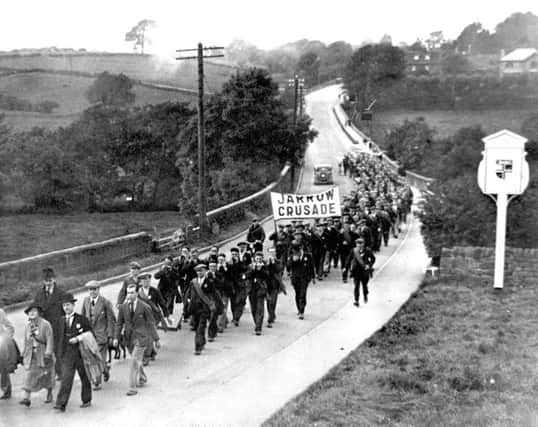Asking how much has changed since Jarrow Crusade?


Now a new book, Long Road from Jarrow: A Journey Through Britain Then And Now, written by Stephen Lambert, has sparked debate over the social and economic changes that have taken place in the meantime, both here and elsewhere – posing the question: ‘Eighty years on, are we going back to the 30s?’
In the light of the publication, North East sociologist Mr Lambert got in touch to say: “Since the end of the Second World War, many people have seen the inter-war period as an age of unmitigated economic failure, marked by mass unemployment, hunger marches, including the famous Jarrow march of 1936, and lengthening dole queues.
Advertisement
Hide AdAdvertisement
Hide Ad“However, this popular view has been challenged by Stuart Maconie, who points out that, although there was great hardship, especially in the North East in the 1930s, it was very unevenly spread out.
“The hardships were very real, particularly for those who lived in the depressed areas of Tyneside and County Durham. Certainly to live in Jarrow was a grimmer experience than to live in the Midlands town of Market Harborough.
“In 1936, Jarrow resembled a ghost town with over 80% cent of the town’s men jobless.”
Yet, says Mr Lambert, in spite of such hardship, the “era did not produce a potential revolutionary situation or extremism as predicted by many contemporaries at the time”.
Advertisement
Hide AdAdvertisement
Hide AdHe added: “Although membership of the Communist Party grew from 2,500 in 1930 to 17,500 by 1939, it made very few advances.
“Likewise as the Newcastle historian Martin Pugh points out, Mosley’s Fascist black shirts, during the period made little impact in the region, even though the British Union of Fascists had over 30,000 members by 1935.”
Despite the passing years, food hand-outs (foodbanks) are now back, prompting Maconie to note: “The ’30s in some ways start to look very much like Britain today, once you’ve wiped away the soot and coal-dust.”
And continuing to take Jarrow as an example, he cites social class as the key division of British society as he reflects upon what he sees as the present north-south divide.
Advertisement
Hide AdAdvertisement
Hide Ad“Eighty years on,” adds Newcastle councillor Lambert, “writers like Stuart Maconie argue that we’re going back to the ’30s, with rising austerity, social inequality and the growth of far-right populism. A gross simplification, argue others.
“Yet it can’t be denied that we’re seeing a widening gulf both between the north and south of England. Just as worrying we appear to be witnessing big gaps opening up in our core cities such as Newcastle, Leeds and Manchester.
“Maconie is correct to emphasise making our country a ‘one-nation society’ again.
“But we also need to strive for a ‘one region society’, if we’re serious about creating a more equitable and fairer community which benefits the many and not the just the few.”
Advertisement
Hide AdAdvertisement
Hide AdLong Road from Jarrow: A Journey Through Britain Then and Now, is published by Ebury Press.
How do you think the fortunes of South Tyneside have changed since the Jarrow Crusade?
Why do you think people in this country, struggling to make ends meet during the ’30s, didn’t embrace Fascism or Communism as they did on the continent?
Please get in touch with your views.